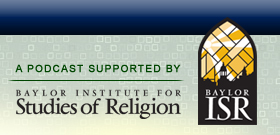

|
Gary Richardson on Religion & Craft Guilds in the Middle Ages  Date: November 2nd, 2014
 Economic historians have long studied and examined the importance of medieval craft guilds on the economic development of Europe. But what importance, if any, did religion play in the formation and maintenance of these professional organizations? Dr. Gary Richardson, professor of economics at the University of California – Irvine, explains that religious belief and ritual were crucial components of guilds in the 14th through 16th century (and much later in many Catholic countries). Prof. Richardson, who is known for his research on 19th and 20th century banking crises, begins by explaining how he came to become interested in medieval guilds as a graduate student. More importantly, he discusses how he came to include religion in his analysis. While examining primary documents related to 14th century guilds, he noted that a majority of these documents were devoted to religious issues and themes. While some scholars in the humanities have known this for some time, economists studying the topic largely ignored these writings in favor of the slim portion of the documents devoted to what one might consider more typical economic content (e.g., issues on physical goods output). Gary had a hunch that this extensive discussion of religion was more than just casual, and may have played an important function in the organization of professional groups. Following his hunch, Gary discovered that many of these guilds originated from prayer societies. It was common for local groups of individuals to gather and pray for salvation and the souls of friends and relatives who were deceased. In an age when the doctrine of purgatory was widely accepted, such prayers held great importance to individuals as witnessed by the significant amount of resources that people would devote to ensuring salvation. Not surprisingly, since certain industries tended to be located in the same place in town for practical reasons — e.g., blacksmiths would all exist in one area to concentrate the smoke and noise (a medieval form of “zoning”) — it was common for people engaged in the same occupation to gather together for worship and prayer. Religious social gatherings would likely include discussion of professional activities and the collective action created for religious purposes naturally made it easier for members of the same profession to coordinate their more secular business dealings. We spend some time discussing what guilds back in the Middle Ages did and how they helped to preserve the reputational quality of the industry. Gary uses the manufacture of pewter in London as a classic example of how craftsmen needed to preserve their reputation. While most pewter of the time contained lead and would tarnish after a certain time, London pewter was known for its high quality and resistance to tarnish. Instead of using lead, these pewter makers used tin and a few other alloys to create a highly desired product, albeit one that was a bit more costly to make. However, since London pewter commanded a higher price on the market, individual manufacturers had an incentive to sneak in lead to their product so as to maximize their profits. When such “cheating” became known, the reputation of all pewter makers tended to suffer. Thus, the guild had to devise ways to monitor and punish individual manufacturers who added lead to their product Religion served as a powerful means of dissuading individuals from cheating. First, we learn that it extended the benefits that accrue from cooperation into the afterlife. While cheating for short-term gain in the present is tempting, losing the prayers for one’s soul while in purgatory discouraged people from cheating in the present. Second, the social networking that occurred in weekly religious gatherings and contributions to regular pageants, plays, and processions also helped guild members monitor each other’s commitment. Gary also discusses how the Black Death changed the dynamic of this arrangement, making religious cooperation under the threat of a “random” early death all the more worrisome for individual guild members. We finish by talking about how the Protestant Reformation (in continental Europe and England) changed the incentive calculations and led religion to become less connected to craft guilds over time. Recorded: October 28, 2014 RELATED LINKS Gary Richardson’s bio and personal webpage at UC-Irvine Department of Economics. Gary Richardson’s papers at National Bureau of Economic Research. The Parish Gilds [sic] of Medieval England, by H.F. Westlake (mentioned in podcast). RELATED PODCASTS Larry Iannaccone on Sacrifice, Stigma, and the Economics of Religion. Mike McBride on the Economics of Religious Leadership. Mike McBride on Religious Free-Riding and the Mormon Church. Colleen Haight on the Oracle of Delphi. Larry Witham on the Economics of Religion. Sarah Bond on the Church and Funerals in Late Antiquity.
Leave a Reply |
 Search The Podcast
To search the podcast, type a term and click the Search button.
  Browse Podcast Categories
Select a category below to browse the podcast:
   |














